
UA120 was a family of American solid rocket boosters, manufactured by the Chemical Systems Division of United Aircraft (later United Technologies Corporation). Several variants existed, with a varying number of segments.

UA120 was a family of American solid rocket boosters, manufactured by the Chemical Systems Division of United Aircraft (later United Technologies Corporation). Several variants existed, with a varying number of segments.

All versions of UA120 shared a common design, with the only significant differentiating factor being the length of the motor. It was a segmented design, with between five and seven motor segments possible. A solid propellant, polybutadiene acrylonitrile (PBAN), was used as fuel. [1] The stage had an external diameter of 120 inches. [2] Attitude control in flight was provided by means of a liquid injection thrust vector control (LITVC) system, with an external nacelle containing nitrogen tetroxide attached to the side of each booster. [2] Solid fueled separation rockets, used to jettison the spent boosters, were affixed at the top and bottom of the stage. [2] Thrust-termination capability, necessary for manned rockets such as the Space Shuttle or Manned Orbiting Laboratory, was to be provided by two pyrotechnically triggered ports on the forward closure, which when opened would allow for the non-propulsive venting of exhaust gasses. [3] The forward end of the stage contained an aerodynamic nose cone, an ignitor, separation rockets, and the forward attachment ring. The aft end contained additional separation rockets, the nozzle, and a heat shield. [2]
The overall design of each variant was very similar, the main difference being the number of segments used. This is indicated by the number at the end of each designation.
UA1205 was used as a strap-on booster on the Titan IIIC, Titan IIID, and Titan IIIE rockets, and was proposed for use on several derivatives of the Saturn rocket family. [1] [2]
The UA1206 was used as a strap-on booster on Titan 34D and Commercial Titan III. [4]
UA1207 was used on Titan IV-A. It was proposed for several other variants of Titan III and IV, as well as derivatives of the Saturn rocket family and the Space Shuttle. [2] [3] [5]

Energia was a super-heavy lift launch vehicle. It was designed by NPO Energia of the Soviet Union for a variety of payloads including the Buran spacecraft. Control system main developer enterprise was the Khartron NPO "Electropribor". The Energia used four strap-on boosters each powered by a four-chamber RD-170 engine burning kerosene/LOX, and a central core stage with four single-chamber RD-0120 (11D122) engines fueled by liquid hydrogen/LOX.

A solid-propellant rocket or solid rocket is a rocket with a rocket engine that uses solid propellants (fuel/oxidizer). The earliest rockets were solid-fuel rockets powered by gunpowder; they were used in warfare by the Chinese, Persians, Mongols, and Indians as early as the 13th century.

Titan was a family of United States expendable rockets used between 1959 and 2005. The Titan I and Titan II were part of the US Air Force's intercontinental ballistic missile (ICBM) fleet until 1987. The space launch vehicle versions contributed the majority of the 368 Titan launches, including all the Project Gemini crewed flights of the mid-1960s. Titan vehicles were also used to lift US military payloads as well as civilian agency reconnaissance satellites and to send interplanetary scientific probes throughout the Solar System.
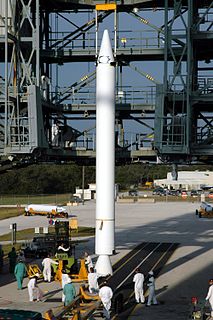
A booster rocket is either the first stage of a multistage launch vehicle, or else a shorter-burning rocket used in parallel with longer-burning sustainer rockets to augment the space vehicle's takeoff thrust and payload capability. Boosters are traditionally necessary to launch spacecraft into low Earth orbit, and are especially important for a space vehicle to go beyond Earth orbit. The booster is dropped to fall back to Earth once its fuel is expended, a point known as booster engine cut-off (BECO).
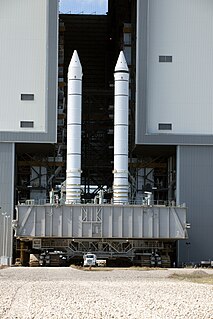
The Space Shuttle Solid Rocket Booster was the first solid-propellant rocket to be used for primary propulsion on a vehicle used for human spaceflight and provided 85% of the Space Shuttle's thrust at liftoff and for the first two minutes of ascent. After burnout, they were jettisoned and parachuted into the Atlantic Ocean where they were recovered, examined, refurbished, and reused.

A solid rocket booster (SRB) is a large solid propellant motor used to provide thrust in spacecraft launches from initial launch through the first ascent. Many launch vehicles, including the Ariane 5, Atlas V, and space shuttle, have used SRBs to give launch vehicles much of the thrust required to place the vehicle into orbit. The space shuttle used two space shuttle SRBs, which were the largest solid propellant motors ever built and the first designed for recovery and reuse. The propellant for each solid rocket motor on the space shuttle weighed approximately 500,000 kilograms.

Titan IV was a family of heavy-lift space launch vehicles developed by Martin Marietta and operated by the United States Air Force from 1989 to 2005. Launches were conducted from Cape Canaveral Air Force Station, Florida and Vandenberg Air Force Base, California.

The Titan IIIC was an expendable launch system used by the United States Air Force from 1965 until 1982. It was the first Titan booster to feature large solid rocket motors and was planned to be used as a launcher for the Dyna-Soar, though the spaceplane was cancelled before it could fly. The majority of the launcher's payloads were DoD satellites, for military communications and early warning, though one flight (ATS-6) was performed by NASA. The Titan IIIC was launched exclusively from Cape Canaveral while its sibling, the Titan IIID, was launched only from Vandenberg AFB.
A liquid rocket booster (LRB) uses liquid fuel and oxidizer to give a liquid-propellant or hybrid rocket an extra boost at take-off, and/or increase the total payload that can be carried. It is attached to the side of a rocket. Unlike solid rocket boosters, LRBs can be throttled down if the engines are designed to allow it, and can be shut down safely in an emergency for additional escape options in human spaceflight.

A retrorocket is a rocket engine providing thrust opposing the motion of a vehicle, thereby causing it to decelerate. They have mostly been used in spacecraft, with more limited use in short-runway aircraft landing. New uses are emerging since 2010 for retro-thrust rockets in reusable launch systems.

Ares I was the crew launch vehicle that was being developed by NASA as part of the Constellation program. The name "Ares" refers to the Greek deity Ares, who is identified with the Roman god Mars. Ares I was originally known as the "Crew Launch Vehicle" (CLV).

Athena was a 1990s Lockheed Martin expendable launch system which underwent several name changes in its lifetime.
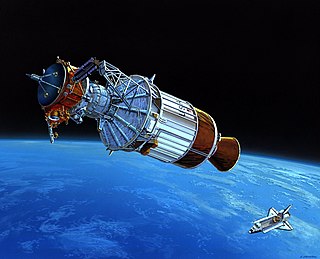
The Inertial Upper Stage (IUS), originally designated the Interim Upper Stage, was a two-stage, solid-fueled space launch system developed by Boeing for the United States Air Force beginning in 1976 for raising payloads from low Earth orbit to higher orbits or interplanetary trajectories following launch aboard a Titan 34D or Titan IV rocket as its upper stage, or from the payload bay of the Space Shuttle as a space tug.

The Saturn II was a series of American expendable launch vehicles, studied by North American Aviation under NASA contract in 1966, derived from the Saturn V rocket used for the Apollo lunar program. The intent of the study was to eliminate production of the Saturn IB, and create a lower-cost heavy launch vehicle based on Saturn V hardware. North American studied three versions with the S-IC first stage removed: the INT-17, a two-stage vehicle with a low Earth orbit payload capability of 47,000 pounds (21,000 kg); the INT-18, which added Titan UA1204 or UA1207 strap-on solid rocket boosters, with payloads ranging from 47,000 pounds (21,000 kg) to 146,400 pounds (66,400 kg); and the INT-19, using solid boosters derived from the Minuteman missile first stage.
The Saturn MLV was a proposed concept family of rockets, intended as a follow-on to the Saturn V. MLV stands for "Modified Launch Vehicle".

The Castor family of solid-fuel rocket stages and boosters built by Thiokol and used on a variety of launch vehicles. They were initially developed as the second-stage motor of the Scout rocket. The design was based on the MGM-29 Sergeant, a surface-to-surface missile developed for the United States Army at the Jet Propulsion Laboratory.
Studied by Douglas Aircraft Company in 1965, this rocket consisted of a whole Saturn IB with 4 strap-on SRBs that have flown on the Titan 3E interplanetary missile carriers. All components of the vehicle have flown, but not together for this concept.
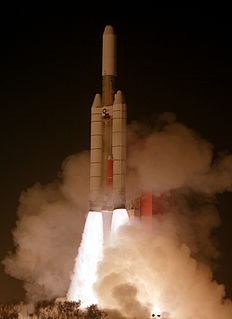
The Titan 34D was a United States expendable launch vehicle used to launch a number of satellites for military applications.
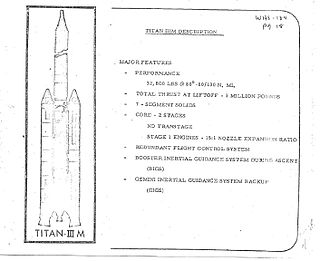
The Titan IIIM was a planned American expendable launch system, intended to launch the Manned Orbiting Laboratory and other payloads. Development was cancelled in 1969. The stretched core stage was used on some versions of the Titan IIIB and the projected UA1207 solid booster rockets were eventually used on the Titan IV.
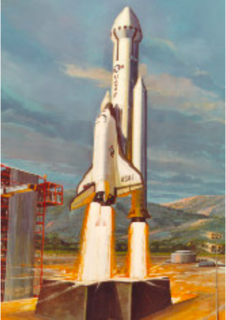
During the lifetime of Space Shuttle, Rockwell International and many other organizations studied various Space Shuttle designs. These studies included different ways to increase shuttle payload capability, crew capacity, and developing standalone reusable launch vehicles. A large focus of the program was towards new shuttle boosters and an upgrades to the external tank but also looked to expand NASA's ability to launch deep space missions and build large modular space stations. Many of these concepts and studies would shape the concepts and programs of the 2000s such as Constellation, Orbital Space Plane Program, and Artemis program.